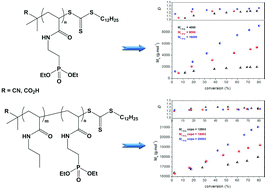Synthesis by RAFT of innovative well-defined (co)polymers from a novel phosphorus-based acrylamide monomer
Abstract
The present contribution reports on the synthesis and controlled

* Corresponding authors
a
Institut Charles Gerhardt Montpellier UMR5253 CNRS-UM2-ENSCM-UM1 – Equipe Ingénierie et Architectures Macromoléculaires, Université Montpellier II cc1702, Place Eugène Bataillon, 34095 Montpellier, France
E-mail:
sophie.monge-darcos@univ-montp2.fr
Fax: +33-467144028
Tel: +33-467144158
b Institut Européen des Membranes-IEM UMR 5635 CNRS-ENSCM-UM2 - Equipe Génie des Procédés Membranaires, Université Montpellier II cc047, Place Eugène Bataillon, 34095 Montpellier, Cedex 5, France
The present contribution reports on the synthesis and controlled

 Please wait while we load your content...
Something went wrong. Try again?
Please wait while we load your content...
Something went wrong. Try again?
A. Graillot, S. Monge, C. Faur, D. Bouyer and J. Robin, Polym. Chem., 2013, 4, 795 DOI: 10.1039/C2PY20720F
To request permission to reproduce material from this article, please go to the Copyright Clearance Center request page.
If you are an author contributing to an RSC publication, you do not need to request permission provided correct acknowledgement is given.
If you are the author of this article, you do not need to request permission to reproduce figures and diagrams provided correct acknowledgement is given. If you want to reproduce the whole article in a third-party publication (excluding your thesis/dissertation for which permission is not required) please go to the Copyright Clearance Center request page.
Read more about how to correctly acknowledge RSC content.
 Fetching data from CrossRef.
Fetching data from CrossRef.
This may take some time to load.
Loading related content
